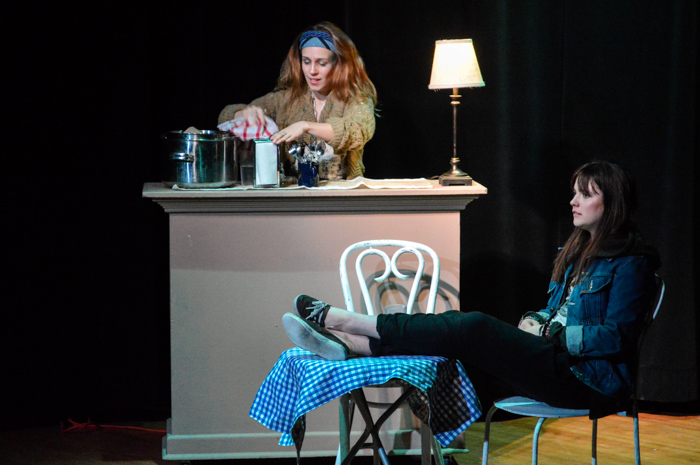The Flood Thereafter was a risky choice for a student production. Tuesday Night Café Theatre (TNC) Directors Daphné Morin and Cleo da Fonseca chose a complex piece that weaves surrealism, small-town identity, and Greek myth together. Coming in closer to two hours than the promised hour and a half, The Flood Thereafter plods along its way to an unsatisfying conclusion, with brief flashes of insight scattered throughout.
The play tells the story of a small fishing town in rural Quebec, told primarily through the lens of a young stripper named June (Camille Banville). June is beloved by the people of the town but feels trapped. When a young trucker named Dennis’ (Jérémy Benoit) truck breaks down, she chases after him and the freedom he represents. June acts as a kind of siren, drawing Dennis ever deeper into the twisted affairs of the town even as she tries to win him as her way out. Their relationship shakes the town out of its established order, allowing hidden stories and secrets to rise to the surface.
The most glaring issue with the production was one of representation.The play features several old, worn-out small town characters that student actors did not show a complete understanding of. Pierre-Luc Senécal plays Homer, a disabled fisherman torn between his duty to his wife and his attraction to June. Senécal’s voice begins with a raspy quality, but loses that along the way. His portrayal never hits the emotional levels available within the text. The agony and confusion of the character don’t come through. Several times throughout the play, his character joins his drinking buddy, George (Thomas Khullar), to watch June dance, a performance that is supposedly so beautiful it makes the men cry. These scenes succeed in a certain way: June is placed behind a screen behind the audience, leaving a bit of uncertainty whether to look at the men or her. This questioning in alignment is a nice touch, but unfortunately the men ham up this scene with over the top gestures, failing to capture anything that looks like genuine desire.
There are multiple moments during the performance where the actors’ performances come off as robotic, rather than indulging in the deeper meaning of their actions. For instance, early in the play George’s character is said to rip up napkins in a diner. In a later scene, George enters the diner and begins to methodically tear the napkins as if it’s part of his job, not as someone taking his frustration out on the environment around him. His partner in that scene, Grace (Morin), plays a mother from a rural town in Quebec. Throughout the show she deftly switches between French and English, but her English is so perfect that it makes her character’s background difficult to believe.
Amalea Ruffett plays Homer’s wife, Penelope, who waits at home as per her namesake. Ruffett utilized a very traditional “Theatre Voice,” which worked when she acted as a storyteller but did not really fit her character. Even though she is made up to look like an older woman, she doesn’t carry herself with any kind of weight that her character’s age suggests. In a scene of seduction where she flirts with Dennis—a much younger man—she manages to seem somewhat seductive but the pent up desire of a loveless marriage is missing, and Benoit and her don’t interact well enough to make the scene compelling.
Benoit and Banville do play the young lovers well—they have enough chemistry to make a sexual pantomime late in the play effective. Benoit is drawn into the whirlpool of the sleepy town, showing his curiosity and frustration successfully, making both his attraction to June and responsibility to his girlfriend believable. Banville aptly captures the innocence of her character, if not her sexuality. A minor gripe with her performance is how she was made to wear a textually significant wig clumsily on top of her hair rather than covering her hair up, another small but significant error that harms suspension of disbelief. The play has a few more of such errors—glasses which are supposed to have ice and don’t, hair that is supposed to be like rope but has clearly been conditioned within a day, and injuries that haphazardly appear and disappear.
These minor errors compound an uninspired direction of dialogue. For a play with an enormous amount of dialogue and long monologues, there are far too many scenes blocked with two characters simply sitting next to each-other looking out into the audience. Furthermore, these scenes of dialogue have far too many pauses, making moments where silence could be powerful less so and slowing the pace even more. While, perhaps this directorial decision was to make the audience feel trapped in the small town with the townspeople, it ultimately comes out boring. Surrealism from the source text is almost absent, only shown through lighting in the dance sequences and the play’s ending.
The Flood Thereafter will be at TNC from Mar. 23-25 at 8 p.m. Tickets are $6 for students.









Thank you for the thoughtful comment.